Nightfall - A Review.
 Sunday, April 10, 2011 at 03:38PM
Sunday, April 10, 2011 at 03:38PM
In the not too distant future, the earth has been plunged into darkness. Supernatural creatures are rising to power in the eternal moonlight, and the human race is being hunted like game. Vampires, Werewolves, and Ghouls are locked in a mortal battle with the Human “Hunters” who dare to defend mankind. They all fight to claim the inky darkness of this changed world as their own... or so they think. Unknown to all, there are unseen hands pulling the strings from behind the curtain of darkness, making and breaking hidden alliances between both friend and enemy clans. In this land of Nightfall, you are the puppet master, and these creatures your unknowing minions.
Nightfall is a competitive Deck Building game created by first time game designer David Gregg, and published by Alderac Entertainment Group (AEG). The Story of Nightfall’s publication is an interesting one, and a source of inspiration for aspiring game designers. Although Nightfall’s designer, David Gregg, had been a collectible card game player for most of his life, he had only recently discovered designer board games when he joined the popular gaming community boardgamegeek.com in 2009. Inspired by his newfound hobby, he began openly working on a game design that would merge the sensibilities of the CCG with some of the popular deck building mechanics found in modern designer games. The game design that was born out of this process was called Chainmaster, named for the unique card chaining mechanism Gregg had devised. Many game designs reach this point of development, and then fade into obscurity, but Gregg’s design was fated for a brush with serendipity; Todd Rowland, AEG’s Senior Brand Manager, had recently pinpointed the need for a competitive deck building game to fill a hole in the game market and AEG’s game catalog. Only a couple of weeks had passed before Rowland ran across the Chainmaster prototype while browsing online message boards. He was impressed by the design, and subsequently, AEG picked up the title for publishing. It’s through this collaboration that Gregg’s first design, Chainmaster, evolved and ultimately found its way to store shelves as the game Nightfall.
In Nightfall, players control a band of supernatural creatures, locked in battle against their opponents. The players compete to build, and utilize a deck of cards representing Vampires, Werewolves, Ghouls, and Humans. Cards are acquired during gameplay to dynamically form a private deck that the player draws from to unleash creatures and actions upon his opponents. Cards can be chained together to form powerful combos, but the cards that are played must be carefully chosen, as other players have the opportunity to add their own cards onto the chain, potentially changing the nature of the original combo entirely. Players use their minion cards to deal damage and block attacks, but any damage that isn’t blocked is issued to the receiving player in the form of wound cards. When all of the wound cards have found their way into the players’ decks, the game ends, and the player with the least amount of wound cards is the winner.
Components:
Cards - Being a card game, Nightfall consists almost entirely of cards. The illustrations on the cards are detailed and vibrant, and share the style of a high quality graphic novel. Even though the cards were illustrated by a handful of different artists, they maintain a consistent art style, delivering a pleasing and cohesive package. The illustrations really help to sell the theme, and make me genuinely curious about the stories behind the characters on the cards.
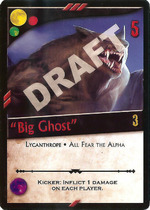 Typical Nightfall creature card.
Typical Nightfall creature card.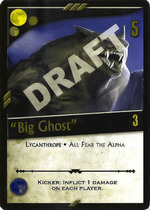 simulated red-green color blindness.The graphic design of the cards is clean, looks nice, and is functional, but there are some areas that I think could have been improved. There is a lot of information that is communicated on every card, but during my first few plays, the lack of iconography made it difficult for some players to differentiate between the number values on the cards. Players would often try to use the influence cost of a card as the attack power, or vice versa. This confusion went away after a few plays, but the confusion could have been avoided entirely with some icons that better conveyed the purpose of each number. The chaining mechanism also relies heavily on recognizing and matching colors. These colors are presented as tinted moon icons. The moon icons are almost identical apart from the color, and in dim lighting it can be difficult to differentiate some of them. This could also pose a problem for players with red-green color blindness, as some of the colors depicted may be indistinguishable. The image on the red moon does have a slight sliver taken out of it, and less contrast than the rest of the icons, to aid those with color blindness, but I'm not sure if the difference is dramatic enough to tell at a glance. If AEG had changed the phase of the moon for each color, or used distinct icons, it could have helped to make the card design accessible to more players.
simulated red-green color blindness.The graphic design of the cards is clean, looks nice, and is functional, but there are some areas that I think could have been improved. There is a lot of information that is communicated on every card, but during my first few plays, the lack of iconography made it difficult for some players to differentiate between the number values on the cards. Players would often try to use the influence cost of a card as the attack power, or vice versa. This confusion went away after a few plays, but the confusion could have been avoided entirely with some icons that better conveyed the purpose of each number. The chaining mechanism also relies heavily on recognizing and matching colors. These colors are presented as tinted moon icons. The moon icons are almost identical apart from the color, and in dim lighting it can be difficult to differentiate some of them. This could also pose a problem for players with red-green color blindness, as some of the colors depicted may be indistinguishable. The image on the red moon does have a slight sliver taken out of it, and less contrast than the rest of the icons, to aid those with color blindness, but I'm not sure if the difference is dramatic enough to tell at a glance. If AEG had changed the phase of the moon for each color, or used distinct icons, it could have helped to make the card design accessible to more players.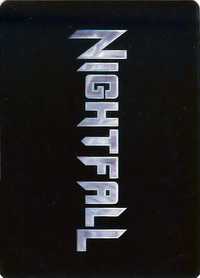 Back of Nightfall card.The cards themselves have a good quality and thickness, However, moving away from the linen textured cards in Thunderstone, AEG has chosen to use smooth paper stock for Nightfall. This wouldn’t normally be a problem, but the back of the cards are almost solid black, so the cards collect noticeable smears and fingerprints when they are handled. Nightfall comes with a coupon for card sleeves, in the box and I would definitely suggest putting the cards in sleeves before playing.
Back of Nightfall card.The cards themselves have a good quality and thickness, However, moving away from the linen textured cards in Thunderstone, AEG has chosen to use smooth paper stock for Nightfall. This wouldn’t normally be a problem, but the back of the cards are almost solid black, so the cards collect noticeable smears and fingerprints when they are handled. Nightfall comes with a coupon for card sleeves, in the box and I would definitely suggest putting the cards in sleeves before playing.
Despite my criticism, when all is said and done, the cards are enjoyable to look at and play with. Most of the concerns about card layout go away after the first few plays, but it is worth mentioning, as it may be a barrier to entry for some.
The Box - It is rare that a game’s box is brought up when talking about components, but Nightfall’s box bears mentioning. Where many deck building games have struggled with the problem of organization, especially with multiple expansions, Nightfall offers an elegant solution. The Nightfall box is large, with a reinforced interior, and two compartments for cards. Custom printed dividers for each of the different card types are included to allow for easy organization and retrieval of the different cards. The cards in Nightfall take up a very small amount of the real estate in the box, with foam spacers taking up the rest of the space. As new expansions are released, spacers can be removed, and the new cards put in their place, allowing for multiple expansions to easily fit in the same box; if the size of the box is any indication, we can expect a lot of expansions in Nightfall’s future.
Theme:
Popular media has seen a flood of vampire and werewolf related themes lately. This can elicit groans from some people when the word “Vampire” is even mentioned. However, the Vampires in Nightfall are more akin to the violent creatures at the end of Quentin Tarantino’s film From Dusk Till Dawn than the kind that would hang out in a high school cafeteria.
Nightfall paints the picture of an apocalyptic future that gives a nod to classic pulp horror; a time when contemporary literature and role playing games hadn’t painted werewolves and vampires as being dire enemies. This pulp horror connection can be found in the short stories that bookend the game’s instructions, 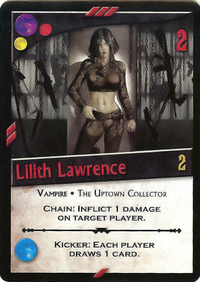 Creature card.and in the subtle nod to The Rocky Horror Picture Show in the gameplay examples.
Creature card.and in the subtle nod to The Rocky Horror Picture Show in the gameplay examples.
What may be my only disappointment with the theme, however, is that it has the potential to paint a rich narrative, but doesn’t really deliver. The short stories in the manual are fun to read, as are the quotes sprinkled throughout. The illustrations on the cards are wonderful, and have such personality. But, all of those things only seem to hint at a deeper story that never materializes. If none of these things were included in the game, I’m not sure that I would even be mentioning the theme. Most other deck building games have a somewhat pasted on theme, and it doesn’t bother me in the slightest. But, that tease of a deeper story in Nightfall really has me wondering who all of these characters are. In another game I might refer to a card as “The card that lets me deal one damage to a player”, but in Nightfall I see “Lilith Lawrence”, and wonder what her story is, and why she hangs all of those weapons on chains when shelving would be much more economical. There are several references to www.hunting-by-night.com in the manual, presented as a site where the hunters post messages. The address is real, but it directs to the nightfall product page. Perhaps AEG has secret plans for the site in the future. I would love to see an ARG style environment where more game fiction might be released.
Mechanics:
Although components and theme add to the overall game experience, the meat of a game is in the gameplay, and this is where Nightfall really shines. It pulls from both the collectible card game and in-game deck building genres to produce a fun game that takes the best of both worlds, while leaving the chaff on the cutting room floor.
One of the biggest complaints about pure deck building games is the anticlimactic feeling of building a deck just for the sake of building a deck. The deck building concept was incubated in the CCG world, where building a deck was just a prelude, but using the deck to defeat your opponents was the main event. The deck building game Dominion pioneered the idea of turning deck construction into a game itself, where players would add to their decks as the game progressed. Whoever built the most efficient deck won the game. However, Dominion’s deck building was more about creating an economic engine than building an unstoppable force, unlike its CCG heritage.
Nightfall brings the direct conflict of the CCG back into the deck building genre. It distances itself from the bureaucracy and politics of medieval feudalism, and replaces it with the pure destructive nature of pulp horror. Nightfall is about action, direct conflict, and power. The creatures in Nightfall live and breathe combat; if they can attack another player, they will, and all you can hope to do is direct their rage. There is no economy, no trading, and no gold in Nightfall; if you want something, you take it by force. The currency of Nightfall is “influence”, which roughly translates to the amount of destructive power you are willing to throw at a problem.
Nightfall also addresses some of the perceived weaknesses of the CCG format; most notably, the tendency for money to buy success. The CCG market is built around the concept of random boosters - a small package with a random assortment of cards. Players collect cards, and build decks with these cards. Players do not know what cards they will get when they purchase a booster, but more powerful cards are usually much rarer in distribution. This usually means that the player who has spent the most money on cards has a higher probability of success. Nightfall levels the playing field, by including all of the cards needed to play in the game box. There are no booster packs to buy, or rare cards to unbalance the game. Some might protest that the variation in player decks is part of the fun in CCGs, and Nightfall has a response to this as well. At the beginning of the game, there is a draft in which players pass cards around the table, and select the cards that they will have exclusive access to. This adds a bit of variation and individuality to each player’s deck.
Setup:
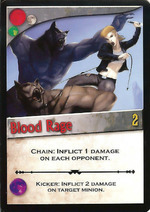 Action card.There are 2 main types of cards in Nightfall: Orders, and Wounds.
Action card.There are 2 main types of cards in Nightfall: Orders, and Wounds.
Orders are the cards that players build their decks with. Orders come in two flavors: action cards and creature cards. Creatures serve the purpose of attacking and blocking for the player, and stay active on the table until the player’s next turn. With Actions, however, the effect is more immediate, and lasts only until the end of the current turn.
Wound cards are put in a player’s deck when he is dealt damage. At the end of the game, the player with the least number of wound cards in his deck wins the game.
Throughout the game, players will be able to acquire order cards fro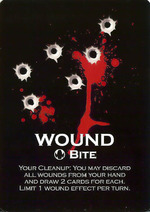 Wound card.m various stacks on the table. These stacks are called “Archives”. There are eight archives, called “Common Archives”, that are available to all players. Each player also has two “Private Archives” that only he has access to.
Wound card.m various stacks on the table. These stacks are called “Archives”. There are eight archives, called “Common Archives”, that are available to all players. Each player also has two “Private Archives” that only he has access to.
Each archive is made up of seven identical copies of an order card, but there is an eighth card in each set with the word “Draft” printed across its face. These draft cards add an interesting level of depth to Nightfall, by turning the game setup into part of the game itself. At the start of the game, the draft cards are collected, and each player is given four of them. The player chooses a card from his draft packet that he wishes to include in his private archives, and passes the remaining cards to the next player.
This process continues until there are two cards left in each packet. Then, the player gets to make a very interesting decision. He gets to choose one card that will go into the common archives (which everyone will have access to) and one card that will be removed from the game entirely. If he chooses a card to put in the common archive, it is possible that his opponents will use it against him, but if he removes it from the game entirely, he denies himself the opportunity to utilize it for his own nefarious purposes. This adds a very strategic element to the game, as choices made here can affect the game in dramatic ways.
After the draft is completed, the remaining draft cards are randomly chosen to complete the common archives. Each draft card is replaced with it's seven matching order cards, private archives are placed next to their owners, and common archives are placed in the middle of the table.
Each player is given an identical prebuilt deck of 12 creature cards, that he shuffles and places face down. He then draws five cards from this deck to form his starting hand.
A pile of wound cards is placed within reach of all the players, and the game proper is ready to begin.
Gameplay:
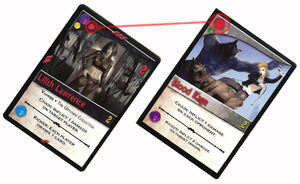 "Lilith Lawrence" has a red link icon, and "Blood Rage" is a red card, therefore "Blood Rage" can link to Lilith.
"Lilith Lawrence" has a red link icon, and "Blood Rage" is a red card, therefore "Blood Rage" can link to Lilith.
The crux of nightfall is in its concept of “Chaining”. When a player puts a card into play, it is called “starting a chain”. Each card has 3 moon shaped icons in its upper left corner, one large, and two small. Each moon icon is tinted with a color. The large icon represents the color of the card. The smaller icons determine which cards can be linked to that card. If the smaller icons are green and blue, then only a green or blue card can be linked to it. Adding cards to a chain is the only way to get them into play. If you play your cards right, you can create long chains that bring many actions into effect and lots of creatures onto the table to fight for you.
The cards in a chain don’t actually take effect until the chain is complete, at which point the cards in the chain are “resolved”. Chains are always resolved from the end first. This means that the last card that has been linked to the chain is the first to resolve, so planning the order of your cards can make a big difference in the effect that they produce. The last cards added to the chain often have the biggest effect. This is important to remember, because after you finish your chain, each other player has the opportunity to add to the end of your chain. This means that they can bring their creatures and actions into play on your turn BEFORE you do, often changing the effects that your cards have. The fact that other players’ cards can piggyback on top of yours, during your turn, really keeps the everyone on their toes.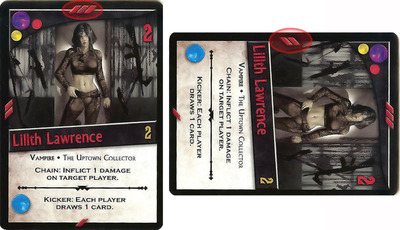 When a creature takes damage, it is rotated to show it's new hit points.Each player’s turn consists of four phases: Combat, Chain, Claim, and Cleanup.
When a creature takes damage, it is rotated to show it's new hit points.Each player’s turn consists of four phases: Combat, Chain, Claim, and Cleanup.
Combat Phase - In your combat phase, any creatures you have on the table MUST attack. The amount of damage that a creature deals is represented by a red number in the upper right corner. You can choose which player each creature attacks, but each defending player determines which of their creatures block. A creature’s heath is represented by red lines on the edges of the card. When the creature takes damage, the card is rotated to reflect his current health. If a creature takes more damage than he has health, the remaining damage is applied to the defending player in the form of wound cards that go into his discard pile. When the attack phase is over, all attacking creatures, and creatures that have been defeated, go back into their owners’ discard pile. This means that once your attack phase is over, all of your creatures are removed from play, so it is very important to get new cards onto the play field, else you become a target for your opponents.
Chain phase - The second phase in play is the chain phase. This is the phase where you can start a chain to bring cards into the game. As described earlier, cards are chained together based on the colors of the moon icons they display. Each card has text on it that describes the card's effect when it is resolved in a chain. There are two types of text: Chain text, and Kicker text. The instructions in the chain text are always 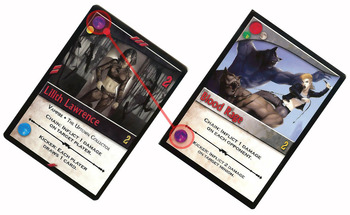 "Blood Rage" has a purple icon for its kicker, and Lilith is a purple card, therefore the kicker text on Blood Rage will be followed when it resolves.followed when a card is resolved. Next to the kicker text, however, is another colored moon icon. If this kicker color matches the color of the card that is being linked to, then the kicker text is resolved as well as the normal chain text. As players get more familiar with the chaining in Nightfall, maximizing kickers becomes a large part of the strategy of the game.
"Blood Rage" has a purple icon for its kicker, and Lilith is a purple card, therefore the kicker text on Blood Rage will be followed when it resolves.followed when a card is resolved. Next to the kicker text, however, is another colored moon icon. If this kicker color matches the color of the card that is being linked to, then the kicker text is resolved as well as the normal chain text. As players get more familiar with the chaining in Nightfall, maximizing kickers becomes a large part of the strategy of the game.
Due to the terminology used in Nightfall, the card text can sometimes be a bit confusing for new players. The term "order" is used to refer to any card that is not a wound card, and the term "target" is used to describe the object that a player can chose to affect. So, when a player is able to chose any non-wound card to apply an effect to, it would be referred to in the card text as a "target order". For example: The action card "Leave Me!" has the text "Chain: You choose the target(s) in target order's text. Kicker: Resolve the text of that order twice". Because the word "order" is a homonym with four distinct meanings, and can be used as both a noun and a verb ("I order you to heed my order.", "order your cards in numerical order."), reading the correct interpretation can take some practice. To add to the confusion, the word "target" can be different parts of speech as well. After a while it becomes second nature to understand that "order" is always used as a noun in the card text referring to an order card, and "target" is never used as a verb. Putting these keywords in bold text or italics, however, might have saved some frustration. There were players in my game group that were definitely turned off by the card text, even though they play Magic: The Gathering, a game that has similar issues with ambiguous text.
Claim phase - This is the phase where you "purchase" new cards, a process called "claiming" in Nightfall. The player starts his claim phase with 2 "influence points". Any influence points that were earned due to card effects in the chain phase are added to this value, and the player may also discard any cards from his hand to gain one influence point per card. A player can claim as many order cards as he wishes, as long as he has the influence to pay for them. Claimed cards go directly into the discard pile. This may seem counter intuitive to players who have never played a deck building game before, but when the player's deck runs out of cards, his discard pile will be shuffled, and the claimed cards in his discard pile will become available. Nightfall cycles through the deck much faster than most other deck building games, so it won't take long before you see your claimed cards in your hand.
Cleanup phase - During your cleanup phase you replenish your hand by drawing cards to bring it back up to five. After you have drawn cards, you may use the effect of one wound card. In this first installment of nightfall, all of the wound cards have an effect that lets you discard any wound cards in your hand, and draw twice the number of discarded cards into your hand. This creates a bit of a catch-up mechanic, allowing players with more wound cards to utilize more cards in their starting hand. In future expansions, wound cards with different effects are planned.
Conclusion:
Nightfall is a lot of fun, it plays well in all of it's player configurations from 2-5. For the two player game, a slightly different drafting process is suggested, and the game may not feel quite as dynamic as a 3+ player game, but it is still enjoyable. However, I would definitely strive to play Nightfall with at least 3 players, as it adds more decisions and strategy to the game.
The chaining mechanism is novel, and makes for some very interesting gameplay decisions. Some people may have trouble understanding the card layout, iconography, and text at first, but given a few plays most of those issues go away. The ability to play cards on your opponents turn, and bring minions into play in response to something in another player's chain is a really creative design choice. It basically eradicates downtime when other players are taking their turn, and adds a bit of psychology to the game. You never know what another player has in their hand and how they might affect your chain.
Putting abilities on the wound cards was also inspired. It keeps all of the players competitive by giving a slight advantage to those with more wound cards. The use of wound cards instead of hit points also works to keep everyone involved in the game. There is no player elimination, so everyone can have fun until the game ends, and no one is stuck sulking in the corner because he was eliminated on the second hand.
Although I didn't mention it in my gameplay description, there is another very creative aspect of Nightfall. All of the character cards in the player's starting deck are removed from the game instead of discarded. This keeps the game moving much more quickly. In games like Dominion, the end game is often slowed down because players have a lot of low level cards that are no longer relevant clogging up their deck. Nightfall automatically solves this problem by creating a limited lifespan for those low level cards by design.
I think Nightfall is very successful in merging the CCG and the deck building genres, and at 30-45 minutes playing time, it's the sort of game that can be played multiple times in a sitting. I hesitate to call it "filler", because there is quite a lot of depth in the game, but that depth is found in layers. Someone can play Nightfall as a beginner, and enjoy the game, but as they become more familiar with the combinations of cards, and the different kickers, a whole new level of card management opens up. Although I have only been playing the game for a couple of weeks, from what I have experienced, I think Nightfall has staying power; and that's not even taking into account the expansions that are planned. In fact, the next expansion to Nightfall, Nightfall: Martial Law, has already been announced for a 2011 release, and will introduce a new gameplay mechanism called "Feeding".
If you like card games, CCGs, and deck building games, and you enjoy a directly competitive experience, then you should go out and pick up a copy of Nightfall. If you don't like conflict in games, are color blind, or tend to avoid games that take a few plays before they really click, then I would recommend playing Nightfall before purchasing. But, I would definitely recommend giving it a try, it's mechanics are unique and refined, and you might be surprised at how much fun you have.
For me, this game is a keeper, and I can't wait to see how David Gregg and AEG evolve both the game, and the shadowy fiction of Nightfall.
Nerdbloggers.com was supplied with a copy of this game by its publisher for the purpose of writing this review. The content of this review was not influenced by advertisers or an affiliate partnership, nor was it written for the sole purpose of promoting a product.
 AEG,
AEG,  Board Games,
Board Games,  David Gregg,
David Gregg,  Nightfall in
Nightfall in  Board Games
Board Games 
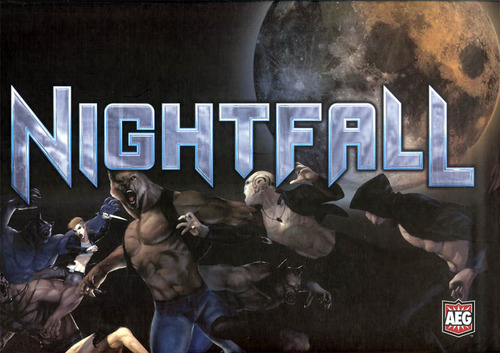
Reader Comments (3)
Hard to tell something concrete about this game. I think it's great, like all the strategies in one!
Great review, containing history about the development and such. Many thanks.
Thanks for reading, and thank you for the kind comment!